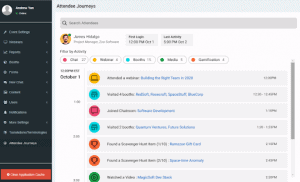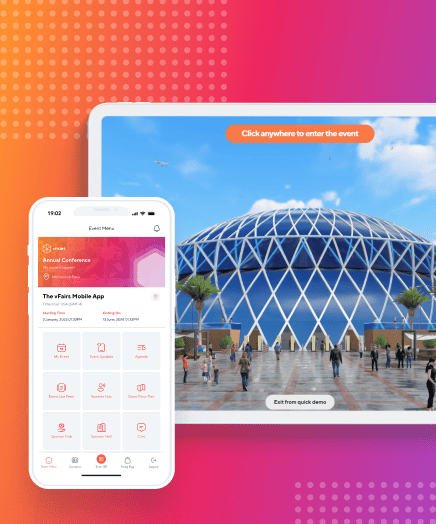Imagine a world of trade fairs where you could easily generate qualified leads from anywhere in the world. While focusing on different audiences, set in different locations, trade fairs have to follow similar rhythms. In 2021, companies are deciding to abandon the original playbook for trade shows. Even for vendors in the event industry, virtual trade shows are the new norm now.
However, even for well-versed businesses, virtual trade shows feel daunting. This is because the transition requires new considerations and invites new — read: virtual — dynamics into your event plan.
One of the best ways to think about virtual trade fairs is simple. You need to reimagine without being restrictive. With the right approach, anyone can replicate the real value of a physical trade show in a virtual show. To make the process easier, we’ve got some trending and tested ways to make it happen.
What are Online Event Industry Trade Fairs?
You may have helped your clients host their own virtual events, but have you considered the benefits of virtual events for your company? Virtual trade fairs offer the event industry a whole new way to sell products and planning services. As your clients begin to move their events online, so too your client base can open up to global companies. Backed by a dynamic 3D environment and tons of tools to engage your global audience, virtual trade fairs can help you win new clients and collect leads with ease.
Wondering what actually makes Virtual trade fair truly exceptional? How are they the top choice of today’s leading businesses? The truth is super low cost, maximum each, and the ability to measure results.

How to Host Event Industry Trade Fairs Online
Below is the checklist to reference before hosting online trade fairs for the events industry.
Pre-Event
Choose The Focus of Your Trade Fair
Similar to a typical physical trade show, the planning of a virtual trade fair starts with a conversation around strategy. You need to think about the virtual event from a high-level perspective. Make sure to consider what areas are of interest to your target audience. Next, consider how these areas relate back to your business goals.
Take this example of an event planners association who’s membership includes event planners, gift vendors, AV solutions, and more. While many of these members have already supported virtual events for their clients, they have not had a chance to sell their products and services through the same channels. Virtual trade fairs are the ideal platform to open up client bases and show new contacts how they can support both in-person, online, and even hybrid events.
You could keep the focus high-level, where you invite all members and their contact bases to attend to see what options are available to them for events. Alternatively, you could focus on one specific area, for example, buyers and vendors who are interested in conducting hybrid conferences within the next year. Either way, the event must have some level of focus and scope.
You see, once you’ve established the general focus of your virtual trade fair, it is easy to map out content ideas to support this concept. Also, it helps in connecting with internal parties and partners who you’d like to involve in the virtual event.

Find a Virtual Event Vendor you Trust
While as a planner, you may already have worked with virtual event companies, or you might be unfamiliar and have to shop around. For your ease, we have highlighted some key features that planners should ask about when deciding on their vendor. This includes how immersive is your platform? What level of customer support and technical support do you offer? What features and tools are available to help me and my vendors hit their goals? What kind of feedback and metrics can we expect from this platform?

Establish Clear Roles and Responsibilities on Your Team
Virtual events may feel like they mostly require technical setup, but the truth is that promotion, content development, and vendor management are all still extremely important aspects. This is just like at a physical event, where you usually require support by various team members
During Event
Create a Cohesive User Experience
Typical trade fairs are exclusively designed to offer step-by-step guidance to attendees. You can provide daily schedules, with signs throughout the event space. This will help direct your attendees to the appropriate rooms. Meanwhile, make sure that the staff is on-hand throughout the event. The staff will answer questions and provide further direction if the attendees need it.
Virtual trade fairs require these same concepts in mind during the planning phase. When attendees land on your virtual web page or landing page, they should be able to locate and access specific resources. Sometimes it’s about tuning into a breakout session or sometimes watching a product demonstration. In both cases, a combination of clear and concise messaging along with clear CTAs scattered throughout the site creates this intuitive feel. Additionally, providing resources like event walk-through videos and help desks will put attendees at ease and provide a more seamless experience.
A website or landing page is the attention to branding. It acts similar to the flow of the virtual trade show. From the displayed imagery to the messaging type, the trade fair must align with the core values of your business. It should be able to build a natural connection to your brand identity.

Offer Opportunities for Engagement
No matter what type of trade show you are hosting, keeping the conversation going is a vital part. It is natural for attendees to crave dialogue. As an event host, it is important to create avenues for it to happen. Thanks to brilliant advancements in technology. You can easily recreate the same engagement opportunities for online trade fairs that work at physical events.
Thinking about this point in the context of a virtual booth. Along with offering digital brochures as well as other marketing collateral, you can also invite event attendees to talk to staff. This can happen at your booth via live chat functionality. Product order sheets are also a great way for vendors to boost sales right within the event.
To do the same for your partners, you can use the same functionality that enhances your exhibitor booth. The partners are more likely to see the event value with more opportunities to directly interact with prospects. They will want to set up their own booths to have meaningful conversations.

Post-Event
Have Follow-Up Measures In Place
Engaging with attendees during a virtual trade show is one thing. The other one is that conversation should never end there. The prime time to build upon this interest and help turn prospects into potential customers is when your products and services are top of mind post-event.
You can start by enrolling all trade fair visitors into a follow-up email nurture campaign. This series of emails will help you in promoting resources that align with the trade show’s focus. You can use top-funnel blog posts to bottom-funnel case studies. The ultimate goal should be helping move prospects down the right path and making them your customer.
Measure Success with Virtual Event Metrics
In order to know how your event went, it is important to consider a few key metrics. From the vFairs backend, you can analyze metrics like user journey, attendee stats, and engagement metrics (booth traffic, document downloads, etc.). The more comprehensive end results you are able to analyze, the more better direction you have to improve in the future.
Also, you can link to event feedback surveys from within the event to get more qualitative feedback to pair with your event’s data.

Conclusion
Trade fairs are a big 2021 revenue generator for a number of companies. Rather than just helping clients find success, virtual trade fairs are great for you to see business results and make new sales too. As a result, you can recreate the magic of traditional trade fairs virtually and continue to bring in new leads.
Trade shows are a great way to promote your brand and showcase your offerings to a diverse group of individuals. Trade fairs provide you with an opportunity to skyrocket your profits. At the same time, none of this is really profitable if it has to come at the cost of innumerable resources, right? Hence, virtual trade fairs are now redefining the profit-maximizing ways while keeping the environment healthy. Guess what? As your business grows beyond borders, more opportunities are just beginning to blossom. Learn more about what it’s like to work with vFairs if you want to host the best virtual trade fair.
Want to Learn More About Virtual Trade Shows?
Check out our Ultimate Guide!
Read It Now


